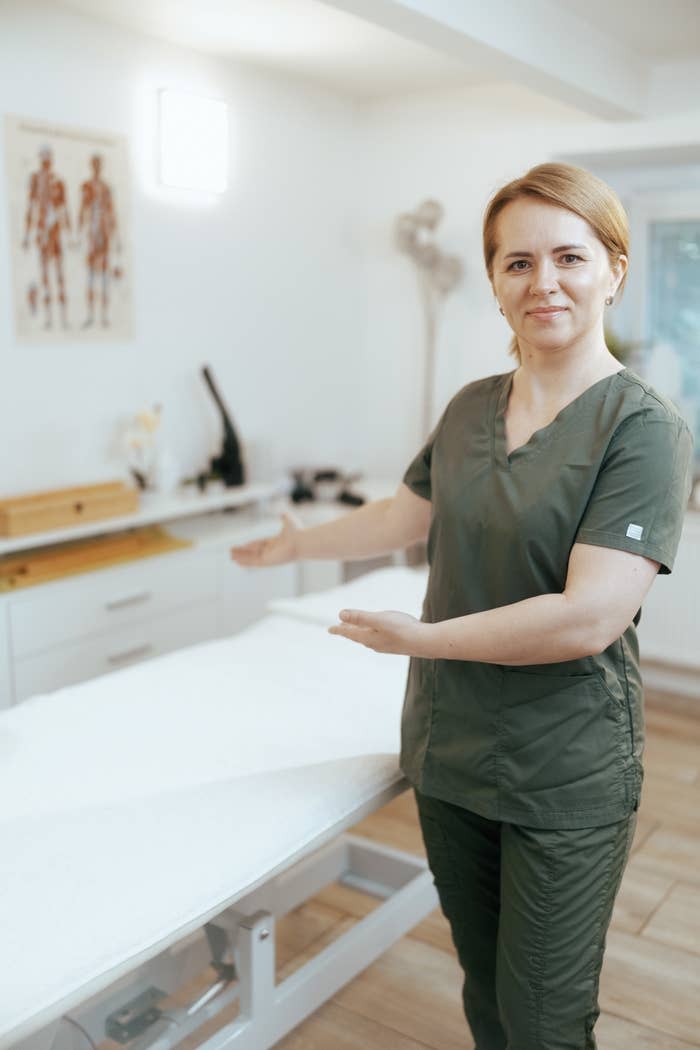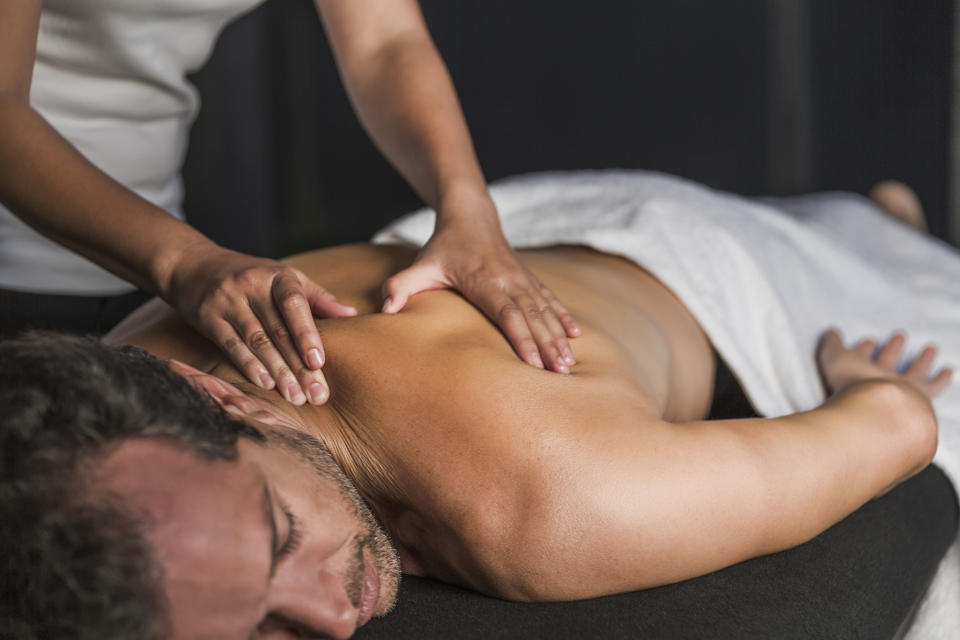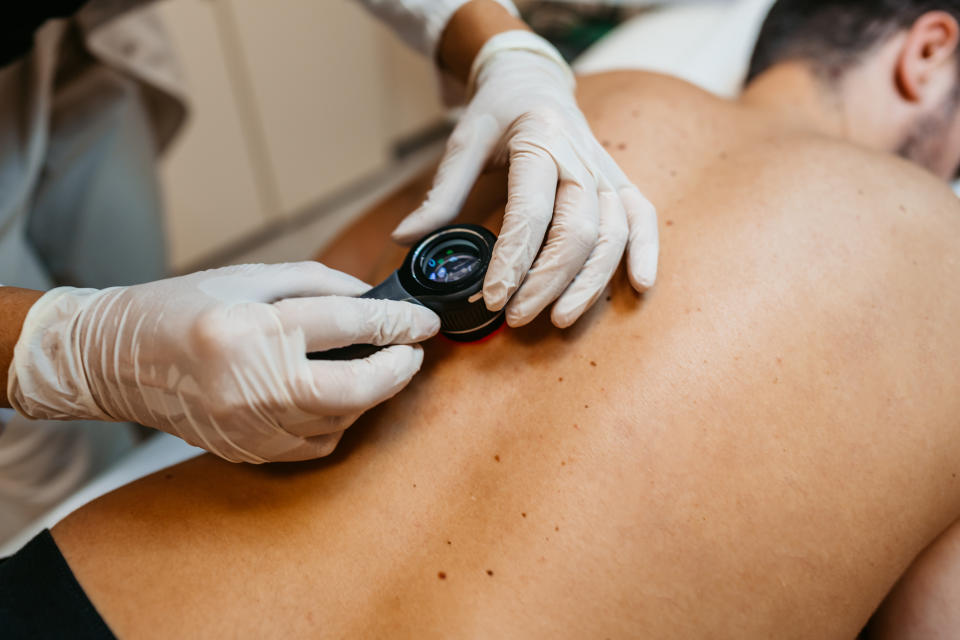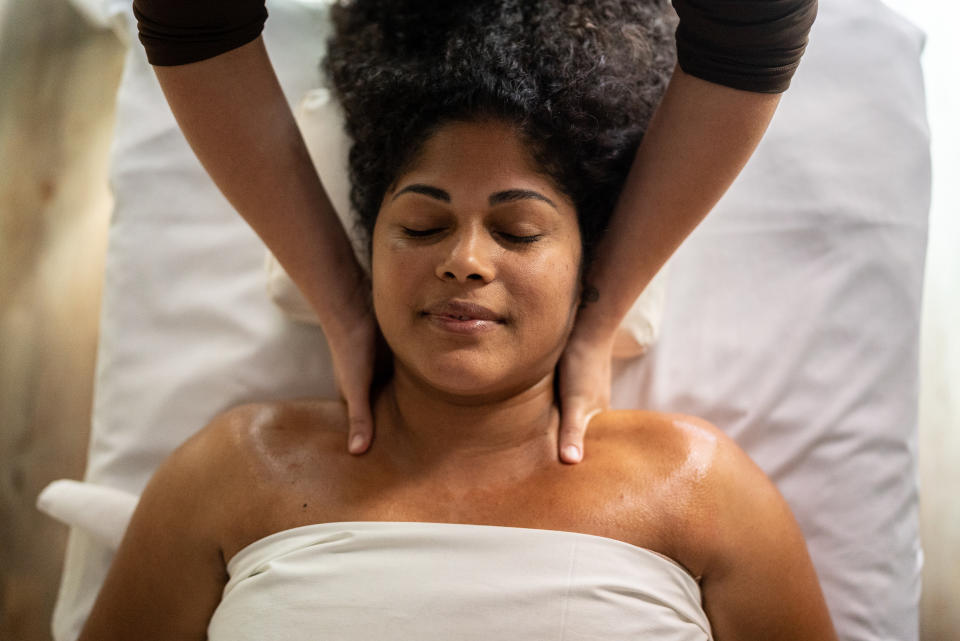If just reading the word “massage” sends you into a reverie of lavender-scented candles and a best-of-Yanni playlist, you probably know how wonderful it can be to receive treatment from a bodywork professional. But while you’re lying there in a blissed-out state, do you ever wonder what your therapist is noticing about your overall health, how you’re dealing with stress, and possibly even what kind of work you’ve been doing?
We talked to professionals all over the country to learn what they notice during a session — and why it’s important.
What they notice when you first arrive

Centralitalliance / Getty Images
Before you even get on the table, your massage therapist is paying attention.
“My awareness of my client starts with the initial greeting,” said massage therapist Kathryn Treat (yep, that’s her real name). “How they carry themselves tells a lot about how they use their body and where restriction, limitation or dysfunction may exist.”
If your massage therapist walks behind you on the way to the treatment room, there might be a good professional reason for that.
“I ask clients to walk ahead of me down the hall,” said massage therapist Dolly Wallace, who is president of the National Certification Board for Therapeutic Massage and Bodywork. “I observe their gait and look to see if shoulders are elevated, if one shoulder or hip is higher than the other if the head is tilting right or left, or if feet either supinate or pronate.”
During the intake process, therapists are alert for clues.
“I take note of things like freedom of movement, symmetry, breathing patterns, and body language,” said massage therapist Cindy Williams. “I also notice things like how fast or loud someone is speaking, how they’re gesturing, and whether they seem fatigued or depressed.”
What they can tell when the massage gets started

Portra / Getty Images
“As soon as I start working, I can tell which areas of the body need more work by the way the muscles and soft tissue feel under my hands,” said massage therapist Kristin Coverly, also director of professional education for Associated Bodywork & Massage Professionals. “I let the body talk to me, to tell me not only which areas to work, but which techniques to use and what level of pressure to apply. What I’m feeling and all of this information my hands are receiving help me make decisions about how much time to spend in a certain area, what techniques to use and what level of pressure is appropriate and beneficial.”
How you’re moving through your day will quickly become apparent to your massage therapist.
“Neck, shoulders and low back are easily the biggest sources of complaint for my clients, because so many of them spend large spans of their day sitting, whether it’s in front of a computer, commuting to work or watching TV,” Treat said.
In addition, massage therapists often know if you’re a runner, because runners often have weak glute muscles, which Treat said is commonly known as “runner’s butt.” And if you’ve got small children at home, she can usually tell from the one-sided “hip hike.”
“It’s caused by carrying kids on one hip predominantly, and it usually results in low back pain,” Treat said.
The work you do — and your stress levels — show up in your body

Ljubaphoto / Getty Images
Our jobs can take a toll on our bodies, which massage therapists notice.
“Many times, I can guess a client’s occupation by their symptoms and findings,” Wallace said. “Long-distance truck drivers will complain of low back pain from the constant jarring of their seat due to bumpy road conditions. Athletes often experience groin pain from having overstretched adductors. Students have neck, shoulder and back pain caused by carrying heavy backpacks.”
Treat also noted: “My clients who work in the trades, like plumbers, electricians, carpenters and drywall contractors, will often come in with overdeveloped forearms, low back pain and a sore neck.”
On or off the job, we all experience stress. And since we’re such unique little unicorns, we carry our stress in different places.
“Each client has a tell-tale stress sign that I can feel for and address during a session, whether it’s the upper shoulders, neck, low back, glutes or jaw,” Coverly said. “An important part of my job is to educate my clients about the areas that tighten when they’re stressed and encourage them to practice targeted self-care to help alleviate pain and discomfort between massage sessions.”
Massage therapist Jeffrey Montoya agreed that stress patterns vary from person to person.
“It’s said that ‘our issues are in our tissues, and that our biography becomes our biology,’ Montoya said. “I do notice patterns, such as how shoulder tension can be a sign that a person is burdened or feeling a lot of responsibility. People with back pain often lack a feeling of being supported in family or work. And anxiety is often associated with stomach and intestinal health issues.”
Professional bodywork can help identify more serious health issues

Urbazon / Getty Images
It’s not all about relaxation, though, because there is a significant health-promoting component to a regular massage regimen. And some of that health-related help might be totally unexpected, thanks to a vigilant therapist. In fact, research about bodywork professionals has shown that they can play a strategic role in helping achieve timely diagnoses for many patients.
The most commonly noticed potential health issues are abnormal-looking moles, or ones that change in appearance over time, especially if they’re on the back or another part of the body that isn’t usually seen. Many an eagle-eyed massage therapist has sent a client to a dermatologist for a timely diagnosis.
Other issues also can arise. “If I notice lumps or adhesions that don’t have the same texture as a regular muscle knot, that’s a good reason to be seen by a doctor,” Treat said. “I had been working regularly with a client, when a lump in their neck seemed different than the others. I suggested making a doctor appointment, and it turned out they had non-Hodgkin lymphoma, thankfully caught in the early stages.”
Their work extends beyond the purely physical, too. If you start crying during treatment, your massage therapist will understand.
“Touch can sometimes trigger a long-buried memory of abuse or injury,” Wallace said. “When those memories are triggered, I’m ready to refer them to a mental health expert who can help.”
There’s value in being “seen, heard and understood”

Fg Trade / Getty Images
“People usually don’t get much time with their primary care provider, but massage therapists are spending an hour at a time with you,” noted Whitney Lowe, director of the Academy of Clinical Massage. “Our clients often develop a strong sense of trust and end up telling us things they don’t tell their primary health care provider. This can be a significant issue, because they may relay important things that change our understanding of what is really going on with an underlying pathology or complaint.”
And finally, here’s a parting thought from massage therapist Angie Parris-Raney, advertising director for ABMP: “In the more than 20 years I’ve been in practice, I’ve come to understand that people just want to be heard, seen and understood, and to have their pain validated,” she said.
“Sometimes, just having a safe and supportive place with someone to deeply listen can already help shift your biology. Massage therapists have a unique opportunity because we work with the entire body, and we can help support the whole being — body, mind and spirit.”
This post originally appeared on HuffPost.
Adblock test (Why?)
We talked to professionals all over the country to learn what they notice during a session — and why it’s important.
What they notice when you first arrive
Centralitalliance / Getty Images
Before you even get on the table, your massage therapist is paying attention.
“My awareness of my client starts with the initial greeting,” said massage therapist Kathryn Treat (yep, that’s her real name). “How they carry themselves tells a lot about how they use their body and where restriction, limitation or dysfunction may exist.”
If your massage therapist walks behind you on the way to the treatment room, there might be a good professional reason for that.
“I ask clients to walk ahead of me down the hall,” said massage therapist Dolly Wallace, who is president of the National Certification Board for Therapeutic Massage and Bodywork. “I observe their gait and look to see if shoulders are elevated, if one shoulder or hip is higher than the other if the head is tilting right or left, or if feet either supinate or pronate.”
During the intake process, therapists are alert for clues.
“I take note of things like freedom of movement, symmetry, breathing patterns, and body language,” said massage therapist Cindy Williams. “I also notice things like how fast or loud someone is speaking, how they’re gesturing, and whether they seem fatigued or depressed.”
What they can tell when the massage gets started
Portra / Getty Images
“As soon as I start working, I can tell which areas of the body need more work by the way the muscles and soft tissue feel under my hands,” said massage therapist Kristin Coverly, also director of professional education for Associated Bodywork & Massage Professionals. “I let the body talk to me, to tell me not only which areas to work, but which techniques to use and what level of pressure to apply. What I’m feeling and all of this information my hands are receiving help me make decisions about how much time to spend in a certain area, what techniques to use and what level of pressure is appropriate and beneficial.”
How you’re moving through your day will quickly become apparent to your massage therapist.
“Neck, shoulders and low back are easily the biggest sources of complaint for my clients, because so many of them spend large spans of their day sitting, whether it’s in front of a computer, commuting to work or watching TV,” Treat said.
In addition, massage therapists often know if you’re a runner, because runners often have weak glute muscles, which Treat said is commonly known as “runner’s butt.” And if you’ve got small children at home, she can usually tell from the one-sided “hip hike.”
“It’s caused by carrying kids on one hip predominantly, and it usually results in low back pain,” Treat said.
The work you do — and your stress levels — show up in your body
Ljubaphoto / Getty Images
Our jobs can take a toll on our bodies, which massage therapists notice.
“Many times, I can guess a client’s occupation by their symptoms and findings,” Wallace said. “Long-distance truck drivers will complain of low back pain from the constant jarring of their seat due to bumpy road conditions. Athletes often experience groin pain from having overstretched adductors. Students have neck, shoulder and back pain caused by carrying heavy backpacks.”
Treat also noted: “My clients who work in the trades, like plumbers, electricians, carpenters and drywall contractors, will often come in with overdeveloped forearms, low back pain and a sore neck.”
On or off the job, we all experience stress. And since we’re such unique little unicorns, we carry our stress in different places.
“Each client has a tell-tale stress sign that I can feel for and address during a session, whether it’s the upper shoulders, neck, low back, glutes or jaw,” Coverly said. “An important part of my job is to educate my clients about the areas that tighten when they’re stressed and encourage them to practice targeted self-care to help alleviate pain and discomfort between massage sessions.”
Massage therapist Jeffrey Montoya agreed that stress patterns vary from person to person.
“It’s said that ‘our issues are in our tissues, and that our biography becomes our biology,’ Montoya said. “I do notice patterns, such as how shoulder tension can be a sign that a person is burdened or feeling a lot of responsibility. People with back pain often lack a feeling of being supported in family or work. And anxiety is often associated with stomach and intestinal health issues.”
Professional bodywork can help identify more serious health issues
Urbazon / Getty Images
It’s not all about relaxation, though, because there is a significant health-promoting component to a regular massage regimen. And some of that health-related help might be totally unexpected, thanks to a vigilant therapist. In fact, research about bodywork professionals has shown that they can play a strategic role in helping achieve timely diagnoses for many patients.
The most commonly noticed potential health issues are abnormal-looking moles, or ones that change in appearance over time, especially if they’re on the back or another part of the body that isn’t usually seen. Many an eagle-eyed massage therapist has sent a client to a dermatologist for a timely diagnosis.
Other issues also can arise. “If I notice lumps or adhesions that don’t have the same texture as a regular muscle knot, that’s a good reason to be seen by a doctor,” Treat said. “I had been working regularly with a client, when a lump in their neck seemed different than the others. I suggested making a doctor appointment, and it turned out they had non-Hodgkin lymphoma, thankfully caught in the early stages.”
Their work extends beyond the purely physical, too. If you start crying during treatment, your massage therapist will understand.
“Touch can sometimes trigger a long-buried memory of abuse or injury,” Wallace said. “When those memories are triggered, I’m ready to refer them to a mental health expert who can help.”
There’s value in being “seen, heard and understood”
Fg Trade / Getty Images
“People usually don’t get much time with their primary care provider, but massage therapists are spending an hour at a time with you,” noted Whitney Lowe, director of the Academy of Clinical Massage. “Our clients often develop a strong sense of trust and end up telling us things they don’t tell their primary health care provider. This can be a significant issue, because they may relay important things that change our understanding of what is really going on with an underlying pathology or complaint.”
And finally, here’s a parting thought from massage therapist Angie Parris-Raney, advertising director for ABMP: “In the more than 20 years I’ve been in practice, I’ve come to understand that people just want to be heard, seen and understood, and to have their pain validated,” she said.
“Sometimes, just having a safe and supportive place with someone to deeply listen can already help shift your biology. Massage therapists have a unique opportunity because we work with the entire body, and we can help support the whole being — body, mind and spirit.”
This post originally appeared on HuffPost.
Adblock test (Why?)




































































































